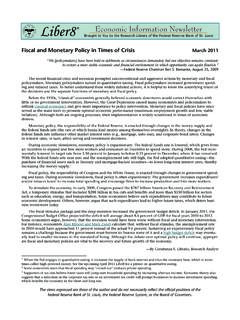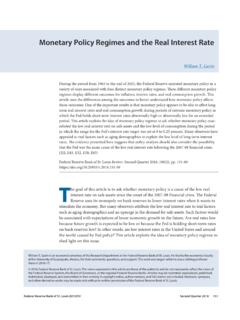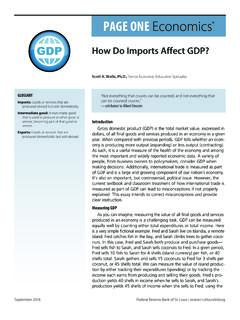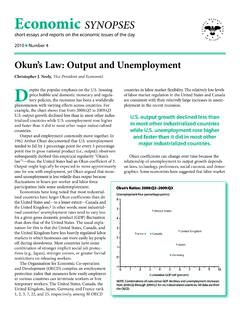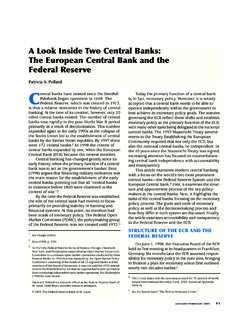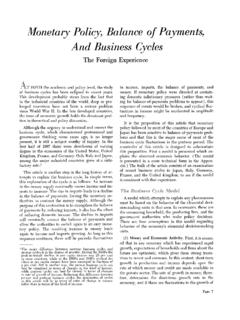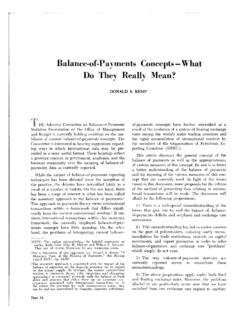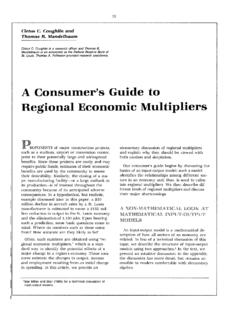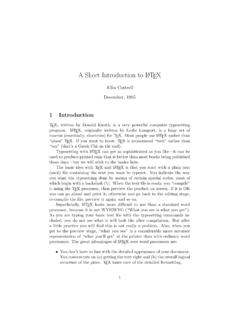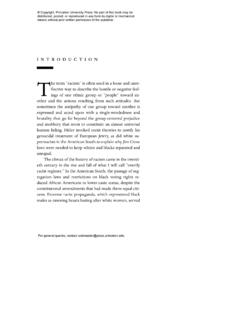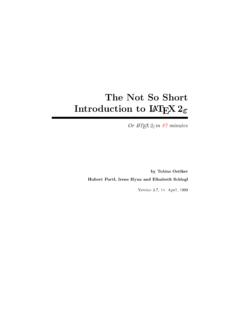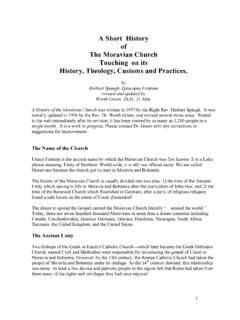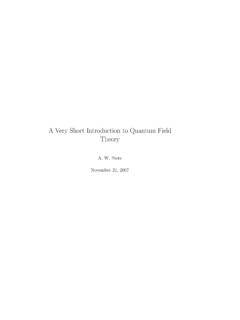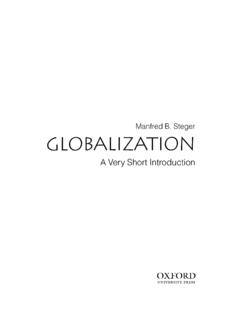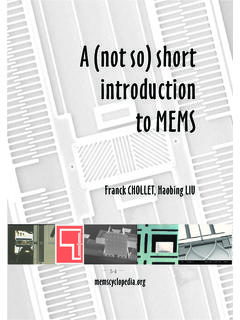Transcription of A Short Introduction to the World of Cryptocurrencies
1 A Short Introduction to the World of CryptocurrenciesAleksander Berentsen and Fabian Sch r1 INTRODUCTIONB itcoin originated with the white paper that was published in 2008 under the pseudonym Satoshi Nakamoto. It was published via a mailing list for cryptography and has a similar appearance to an academic paper. The creators original motivation behind Bitcoin was to develop a cash-like payment system that permitted electronic transactions but that also included many of the advantageous characteristics of physical cash. To understand the spe-cific features of physical monetary units and the desire to develop digital cash, we will begin our analysis by considering a simple cash CashCash is represented by a physical object, usually a coin or a note. When this object is handed to another individual, its unit of value is also transferred, without the need for a third party to be involved (Figure 1).
2 No credit relationship arises between the buyer and the seller. This is why it is possible for the parties involved to remain anonymous. The great advantage of physical cash is that whoever is in possession of the physical object is by default the owner of the unit of value. This ensures that the property rights to the units In this article, we give a Short Introduction to Cryptocurrencies and blockchain technology. The focus of the Introduction is on Bitcoin, but many elements are shared by other blockchain implementations and alternative cryptoassets. The article covers the original idea and motivation, the mode of operation and possible applications of Cryptocurrencies , and blockchain technology. We conclude that Bitcoin has a wide range of interesting applications and that cryptoassets are well suited to become an important asset class.
3 (JEL G23, E50, E59)Federal Reserve Bank of St. Louis Review, First Quarter 2018, 100(1), pp. 1-16. Berentsen is a research fellow at the Federal Reserve Bank of St. Louis and a professor of economic theory at the University of Basel. Fabian Sch r is managing director of the Center for Innovative Finance at the Faculty of Business and Economics, University of Basel. 2018, Federal Reserve Bank of St. Louis. The views expressed in this article are those of the author(s) and do not necessarily reflect the views of the Federal Reserve System, the Board of Governors, or the regional Federal Reserve Banks. Articles may be reprinted, reproduced, published, distributed, displayed, and transmitted in their entirety if copyright notice, author name(s), and full citation are included.
4 Abstracts, synopses, and other derivative works may be made only with prior written permission of the Federal Reserve Bank of St. Reserve Bank of St. Louis REVIEW First Quarter 2018 1 Berentsen and Sch r2 First Quarter 2018 Federal Reserve Bank of St. Louis REVIEWof value circulating in the economy are always clearly established, without a central authority needing to keep accounts. Furthermore, any agent can participate in a cash payment system; nobody can be excluded. There is a permissionless access to it. Cash, however, also has disad-vantages. Buyers and sellers have to be physically present at the same location in order to trade, which in many situations makes its use impracticable. Digital CashAn ideal payment system would be one in which monetary value could be transferred electronically via cash data files (Figure 2).
5 Such cash data files retain the advantages of physical cash but would be able to circulate freely on electronic A data file of this type could be sent via email or social media channels. A specific feature of electronic data is that it can be copied any number of times at negli-gible cost. This feature is highly undesirable for money. If cash data files can be copied and the duplicates used as currency, they cannot serve as a payment instrument. This problem is termed the double spending problem. Electronic Payment SystemsTo counteract the problem of double spending, classical electronic payment systems are based on a central authority that verifies the legitimacy of the payments and keeps track of the current state of ownership. In such systems, a central authority (usually a bank) manages the accounts of buyers and sellers.
6 The buyer initiates a payment by submitting an order. The GoodsCash transactionBuyerSellerFigure 1 Cash TransactionGoodsElectronic paymentBuyerSellerCtrlC+Figure 2 Electronic PaymentBerentsen and Sch rFederal Reserve Bank of St. Louis REVIEW First Quarter 2018 3central authority then ensures that the buyer has the necessary funds and adjusts the accounts accordingly (Figure 3).Centralized payment systems solve the double spending problem, but they require trust. Agents must trust that the central authority does not misuse the delegated power and that it maintains the books correctly in any state of the World that is, that the banker is not running away with the money. Furthermore, centralized systems are vulnerable to hacker attacks, technical failures, and malicious governments that can easily interfere and confiscate Stone Money of YapThe key feature of the Bitcoin system is the absence of a centrally managed ledger.
7 There is no central authority with an exclusive right to keep accounts. In order to understand how this is possible, we will first discuss a historical payment system that has certain similarities with the Bitcoin system. On Yap Island, large millstone-like stones were used as a medium of The stones were quarried almost 280 miles away on the island of Palau and brought to Yap by small boats. Every inhabitant could bring new stone money units into the system. The money creation costs, in the form of labor effort and equipment such as boats, protected the economy from of having to laboriously move the stones, which are up to 13 feet in diameter, with every transaction from a buyer s front yard to a seller s front yard, the ownership rights were transferred virtually. A stone remained at its original location, and the unit of value could be detached from it and circulated irrespective of the stone s whereabouts.
8 It was sufficient that all the inhabitants knew who the owner of every stone was. The separation between the unit of value and the stone went so far that even the unit of value for stones that were lost at sea remained in circulation. The stone money of Yap can therefore be described as a quasi- virtual currency, as each unit of value was only loosely linked to a physical 3 Payment System with a Central AuthorityBerentsen and Sch r4 First Quarter 2018 Federal Reserve Bank of St. Louis REVIEWThe Yap system was based on a distributed ledger, in which every inhabitant would keep track of a stone s ownership. When a buyer made a purchase, this person told his or her neigh-bors that the stone now belonged to the seller. The neighbors then spread the news until finally all of the island s inhabitants had been informed about the change in ownership (Figure 4).
9 Through this communication, every islander had a precise idea of which unit of value belonged to which person at any point in time. In its essential features, the Yap payment system is very similar to the Bitcoin system. A major difference is that in the Yap system false reports could not be immediately identified, so conflicts regarding the current state of the implicit ledger would have to be argued and settled by the group. The Yap system therefore was restricted to a group of manageable size with close relationships, in which misconduct could be punished by the group. In contrast, the Bitcoin system is designed to function in a network where no participant can trust any other participant. This feature is necessary because it is a permissionless payment system in which participants can remain anonymous through the use of Bitcoin and the Bitcoin BlockchainBitcoin is a virtual monetary unit and therefore has no physical representation.
10 A Bitcoin unit is divisible and can be divided into 100 million Satoshis, the smallest fraction of a Bitcoin. The Bitcoin Blockchain is a data file that carries the records of all past Bitcoin transactions, including the creation of new Bitcoin units. It is often referred to as the ledger of the Bitcoin GoodsStone ownershipBuyerSellerCommunicationFigure 4 Payment System with a Distributed LedgerBerentsen and Sch rFederal Reserve Bank of St. Louis REVIEW First Quarter 2018 5system. The Bitcoin Blockchain consists of a sequence of blocks where each block builds on its predecessors and contains information about new Bitcoin transactions. The average time between Bitcoin blocks is 10 minutes. The first block, block #0, was created in 2009; and, at the time of this writing, block #494600 was appended as the most recent block to the chain.

